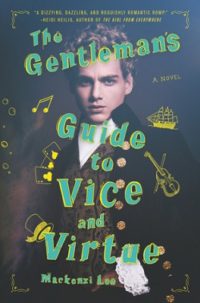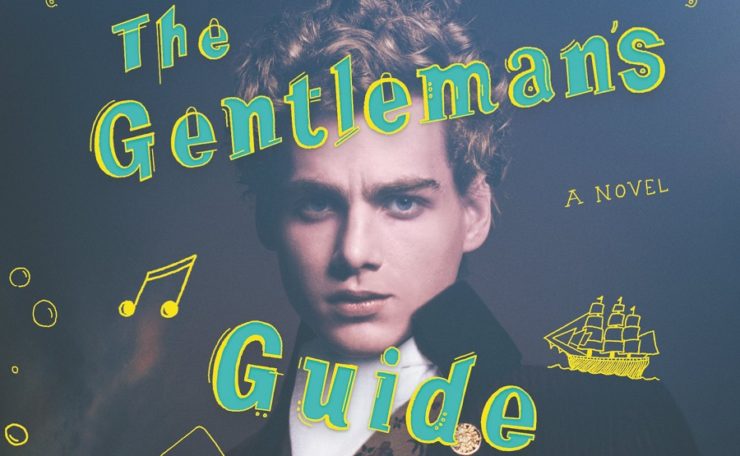Oh, The Gentleman’s Guide to Vice and Virtue, how do I love thee? Let me count the ways. It’s young adult historical fiction set in the Georgian period. It has just enough magic to entertain the magic geeks but not so much to turn off the fantasy naysayers. It’s a will-they-won’t-they romance disguised as an adventure fic with a helping of family drama. And best of all it’s diverse, inclusive, feminist, and wonderfully queer. In case you can’t tell, I absolutely adored this book.
It may only be August, but there’s a strong chance Gentleman’s Guide is going to end up being one of my favorite YA SFF books of the year. It’s the queer YA historical fantasy adventure you’ve been waiting for.
Henry Montague is exactly what a gentleman ought not to be. He’s a booze hound and a rake, a seductive charmer with an allergy to keeping his breeches on. His heartless hard-ass of a father has had enough. He sends Monty, along with his sister Felicity and bestie Percy, on a Grand Tour of Europe. Where Monty sees it as one last hurrah, his father is determined to force some education and gravity on him whether he wants it or not. The boys will, under the guidance of a strict supervisor, learn all about the Continent’s art and culture. After depositing Felicity at a girls’ school where she will acquire all the necessary accomplishments to secure a high-ranking husband, Percy will head off to Holland to law school and Monty will return to England to become the dour man his father demands. At least that’s the plan, and nothing ever goes according to plan.
One night in Versailles, Monty gets roaring drunk, makes a pass at a courtesan, humiliates the Duke of Bourbon, steals from the palace, and runs buck naked through the gardens. Their hasty retreat the next day is beset by highwaymen and suddenly the three teens find themselves on their own and in possession of an alchemical treasure. Their rerouted Tour acquires new guides in European carnies, pirates on the Mediterranean, and a pair of suspicious Catalonian siblings as they troupe through France, Barcelona, and Venice. Between Felicity’s intelligence, Percy’s mettle, and Monty’s stubbornness, nothing can stand against them.
Monty isn’t an easy character to like by any means. On the surface he has more negative qualities than good ones, but there’s so much more going on with him than meets the eye. At the start of the novel he’s heedless, rakish, and self-centered. By the end he still is but with an overlaying maturity and sense of responsibility to temper the worst bits. His character development isn’t a complete overhaul, but he does end up better than when he started. He earns Percy and Felicity’s respect and friendship rather than assuming he deserved it because of his privilege.
What makes Monty such a great character is his capacity to learn from his (many … like, so, so many) mistakes. Monty fails repeatedly throughout the novel, from simple tasks to strategies to understanding his companions. But what’s important is that he both learns why he was wrong and how he can be better in the future. In particular, when Percy or Felicity challenge him on things where his white male privilege has blinded him to other perspectives, he shuts up and listens. It doesn’t matter that he can’t always relate to what they’re dealing with; he listens to their complaints, accepts them as truth, then does his best to use his privileged position to improve theirs, just like a good ally should. Or, to put in Monty’s terminology, “Perspective is a goddamn son of a bitch.”
Monty is the main protagonist, but he shares center stage with Felicity and Percy. Felicity wants education, choice, and personal freedom, or the very things Monty is being handed on a silver platter yet doesn’t want. (And looks like we’ll get to see her wanderlust in action in the recently announced sequel, A Lady’s Guide to Petticoats and Piracy.) Percy’s disability is as much a part of his identity as his Blackness. Lee draws strong parallels to people trying to “fix” his disability and those demanding Monty “straighten up.”
Now, because this is historical fiction, none of the characters ever describe themselves as disabled, feminist, or queer. Lee doesn’t let the restrictions of Georgian etiquette limit her characters, however. Monty never outright calls himself bisexual, but his identity is obvious. We don’t know enough about Percy’s past attractions to know his identity beyond whatever may or may not be going on with Monty, but he’s definitely on the glittering queer spectrum. Like Monty, Felicity pushes back against what high society insists her role should be as a woman. There are hints that Felicity may not be straight either, but I’ll leave it there for spoilers.
Maybe it’s because I just re-watched Belle, but I would’ve liked to see a little more of Monty’s perspective on race. Slavery is still going strong at the time of the novel, and the abolitionist movement in its infancy. The slave trade wouldn’t be outlawed until 1808 and Black slavery not until 1834 (Indian slavery was legal until 1843). Monty needed to explore his understanding of race and racism in Great Britain. I think having him and Percy wrestle with whether or not Monty is acting colorblind, choosing to overlook in Percy what society defines as flaws based on his racial heritage, or accepting Percy’s Blackness as a part of his identity. Of course, I know where Monty falls on that spectrum, but it still needed to be addressed.
 But really, that’s my only quibble. Mackenzi Lee is a firecracker writer. From script to story to characters everything was fun, heady, and enchanting. The plot was twisty and turny without being overly complex or overpowering. The villain just wicked enough, the action just dangerous enough, and the supporting aides, interlopers, and antagonists textured enough to feel real in the moment. If you’re looking for hardcore Georgian/Regency fantasy, this isn’t the novel for you (may I suggest Alison Goodman’s amazing Lady Helen trilogy). Alchemy, resurrection, and fortune telling are all there, but they don’t run the show.
But really, that’s my only quibble. Mackenzi Lee is a firecracker writer. From script to story to characters everything was fun, heady, and enchanting. The plot was twisty and turny without being overly complex or overpowering. The villain just wicked enough, the action just dangerous enough, and the supporting aides, interlopers, and antagonists textured enough to feel real in the moment. If you’re looking for hardcore Georgian/Regency fantasy, this isn’t the novel for you (may I suggest Alison Goodman’s amazing Lady Helen trilogy). Alchemy, resurrection, and fortune telling are all there, but they don’t run the show.
I luxuriated in The Gentleman’s Guide to Vice and Virtue. Took me weeks to finish it, not because it was a slog but because I didn’t want it to end. I savored it in bites, like sampling a rich dessert. To get all Georgian/Regency on you, think a mix of a Jane Austen comedy with Maria Edgeworth’s Regency feminism, and Laurence Sterne’s bawdy charm and spicy travelogues. I can’t wait to read it again.
The Gentleman’s Guide to Vice and Virtue is available from HarperTeen.
Alex Brown is a teen librarian, writer, geeknerdloserweirdo, and all-around pop culture obsessive who watches entirely too much TV. Keep up with her every move on Twitter and Instagram, or get lost in the rabbit warren of ships and fandoms on her Tumblr.










